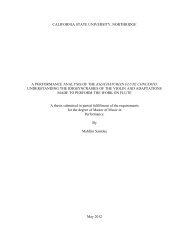2644 - CSUN ScholarWorks - California State University, Northridge
2644 - CSUN ScholarWorks - California State University, Northridge
2644 - CSUN ScholarWorks - California State University, Northridge
Create successful ePaper yourself
Turn your PDF publications into a flip-book with our unique Google optimized e-Paper software.
Journal of Student Research Abstracts · 33<br />
gellate, to represent marine life. I hypothesized that if car wash detergent is harmful to the health of marine<br />
life, then the colony of Pyrocystis lunula to which the car wash detergent is added will produce less intense<br />
blue-green bioluminescence when agitated than a colony to which plain salt water is added. To answer my<br />
question, I prepared a 150 ml solution of salt water containing two drops of car wash detergent. This solution<br />
served as the polluted water and simulated the concentration of car wash detergent that can be found in parts<br />
of the ocean. The· experiment was then carried out in a dark room at 8:30a.m., two hours into the dinoflagellate's<br />
night cycle when bioluminescence is at its peak. I filled each of the wells of the microwell plate with<br />
equal volumes of dinoflagellates. I then placed two drops of plain salt water (control) into twelve of the wells<br />
and two drops of the polluted salt water (experimental) into the other twelve wells. Each microwell was then<br />
stirred to agitate the dinoflagellates. I recorded the brightness of each well's bioluminescence on a scale from<br />
0 (no bioluminescence produced) to -5 (bright blue-green bioluminescence produced). The average measured<br />
bioluminescence for the dinoflagellates in the plain salt water was 4.83, compared to 3.29 for the dinoflagellates<br />
in the polluted salt water. I then ran the t-test, which resulted in at value of 7.7 and probability of less<br />
than 0.1% that my results were due to chance variation alone. This allowed me to reject the Null Hypothesis<br />
and conclude that the brightness of blue-green bioluminescence produced by the dinoflagellates in the car wash<br />
water was significantly less than the brightness of blue-green bioluminescence produced by the dinoflagellates<br />
in the plain salt water. Furthermore, since the rule regarding the health of dinoflagellates is brighter bioluminescence<br />
is better and dinoflagellates are a representation of marine life, I concluded that car wash detergent<br />
is harmful to the health of marine life.<br />
2709<br />
THE EFFECTS OF THE LICHEN CLADINA RANGIFERINA UPON E. COLI AND<br />
B. CERUES.<br />
Nicholas R. Chladek and Steve DeGusta (instructor). John F. Kennedy High School, 6715 Gloria Drive,<br />
Sacramento, CA 95831.<br />
The principle objective of this experiment was to determine if the lichen Cladina rangiferina produces an<br />
antibiotic that effectively inhibits the growth of the bacteria E. coli and B. cereus. Lichen contains a fungus;<br />
and fungus are known to produce antibiotics. This experiment tested whether the fungus in the lichen Cladina<br />
rangiferina produces an effective antibiotic against the growth of B. cereus and E. coli. The effective diameter<br />
for inhibition of bacterial growth is five millimeters for the radius, or 12 millimeters for the diameter of circle<br />
of inhibition surrounding the lichen-extract disks. The lichen extract was made from a 0.5-gram portion from<br />
the body of the lichen that was then ground using a mortar and pestle, and finally added to 10 ml of methyl<br />
alcohol (100%). The extract was added to filter paper disks, made using a standard hole punch; and methanol<br />
was added to control filter paper disks as a control. B. cereus was aseptically transferred to a nutrient agar test<br />
tube, then spread onto a petri dish. The dish was separated into four equal sections by using a permanent marker<br />
to draw four quadrants. Two control disks were added to two quadrants, and the two experimental disks were<br />
added to the two remaining quadrants. The same process was repeated using E. coli. The lichen-extract disks<br />
consistently exhibited circles of inhibition, in both E. coli and B. cereus, that were 12 millimeters in diameter.<br />
After using the t-test, I confirmed that any methanol remaining on the control disks did not inhibit either E.<br />
coli or B. cereus (p













